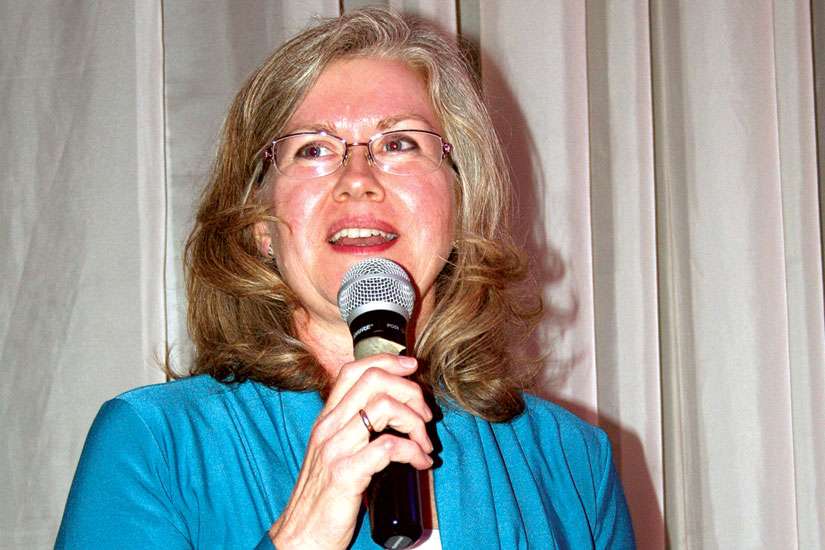Mary Klingenberg offered a strong counterweight to the increased calls for greater access to euthanasia and assisted suicide. The province of Quebec has already passed a “medical aid in dying law” and the Carter case currently before the Supreme Court of Canada is challenging Criminal Code statutes against euthanasia and assisted suicide.
Klingenberg works at the Dr. Bob Kemp Hospice in Hamilton and previously served in neo-natal intensive care — a setting that also often involved a form of palliative care, although at a far different stage of life.
Klingenberg said in any scenario, society has much yet to learn about living and dying.
“Why is this coming up? How did we get here?” she asked.
Technology, instant gratification and having just about everything at our fingertips at all times heighten our expectations of life and what is possible, while leading us to believe we can control just about everything, she said. However, suffering and dying disrupt that paradigm and consequently, we either try to avoid these subjects or can’t deal with them.
Meanwhile, the media and the modern dialogue emphasize that we should be free of worry, stress and anxiety while enjoying maximum choices. Some suffering is seen as unacceptable and death is cast as a problem that simply needs to be managed. This means there is less room for those aspects of life that do not fit in with such an approach to life.
“We’re very unfamiliar with the journey of illness and death,” so that death is no longer being seen as part of the natural rhythm of life, said Klingenberg. This avoidance results in a situation where the dying can feed a sense of shame for being a burden on others.
But Klingenberg proposed an approach in which things are learned, suffering is given meaning and we work to help each other. Hospice palliative care is one path to that goal. Such care celebrates life for as long as it naturally lasts, with a person-centred focus, not a health system one. It also emphasizes the whole person, is a combination of “art” and science, administers the latest in pain and symptom management and tries to create a supportive and spiritual — though not necessarily religious — journey.
Klingenberg offered startling examples of the success of hospice palliative care. Margaret was one woman who arrived at the Dr. Bob Kemp Hospice with no hope and had no idea she could live any kind of life that was enjoyable and productive. But she eventually found the hospice experience to be like “gold” for her.
Charles attended the hospice’s day program with no expectation he could ever be comfortable. But he gradually did find that comfort, as well as a circle of friends and relief from his anxiety. Four months later, he “had a big smile on his face,” was happy, enjoyed dignity, respect and attention and was enjoying his food.
Betty was a woman who was extremely worried about burdening her family, but after she entered the hospice, she described it as feeling like coming home. She could “feel the love” and found it to be a place where she could learn, process and grow. She also took art therapy and produced amazing painted work. She later exclaimed that she was “excited about getting to heaven.”
Finally, Darlene was so dejected when she arrived with terminal cancer that she did not want to leave her room, as she felt there was nothing left to live for. To worsen matters, she had a history of having been raped, abused and losing her 12-year-old child to death. “She was a picture of misery,” said Klingenberg. “This was total pain.”
But very slowly, over a period of months, Darlene came out of her cocoon. She was able to connect and accept little touches of love and became a changed woman. Although she probably would have chosen euthanasia when she entered the hospice, by the end she was able to say, “I had to come here to die to learn how to live.”
“There are lessons in all of this,” said Klingenberg. “People live longer and better in palliative care. Never underestimate the power of being fully present. We are made for connection.”
She added that sometimes the kind of healing that is needed is emotional and spiritual. The problem is that few do anything meaningful to prepare for death.
“We need to pay attention to our spiritual selves … Those who have denied their spiritual selves have been the hardest to treat.”
Klingenberg urged everyone to “become more loving … more able to see, hear and honour one another.” There is a tragedy in being so busy with life that one comes to the place of dying unprepared.
“We need to teach our children about life and death and take it out of the back room.”
Also needed is better access to, and funding for, hospice palliative care (at Bob Kemp, attendees and their families pay nothing), prayer and community support.
“How far are we ready to walk with those who suffer?” she asked, adding that it is sometimes in the scars that we find healing.
(Gosgnach is a freelance writer in Hamilton, Ont.)

